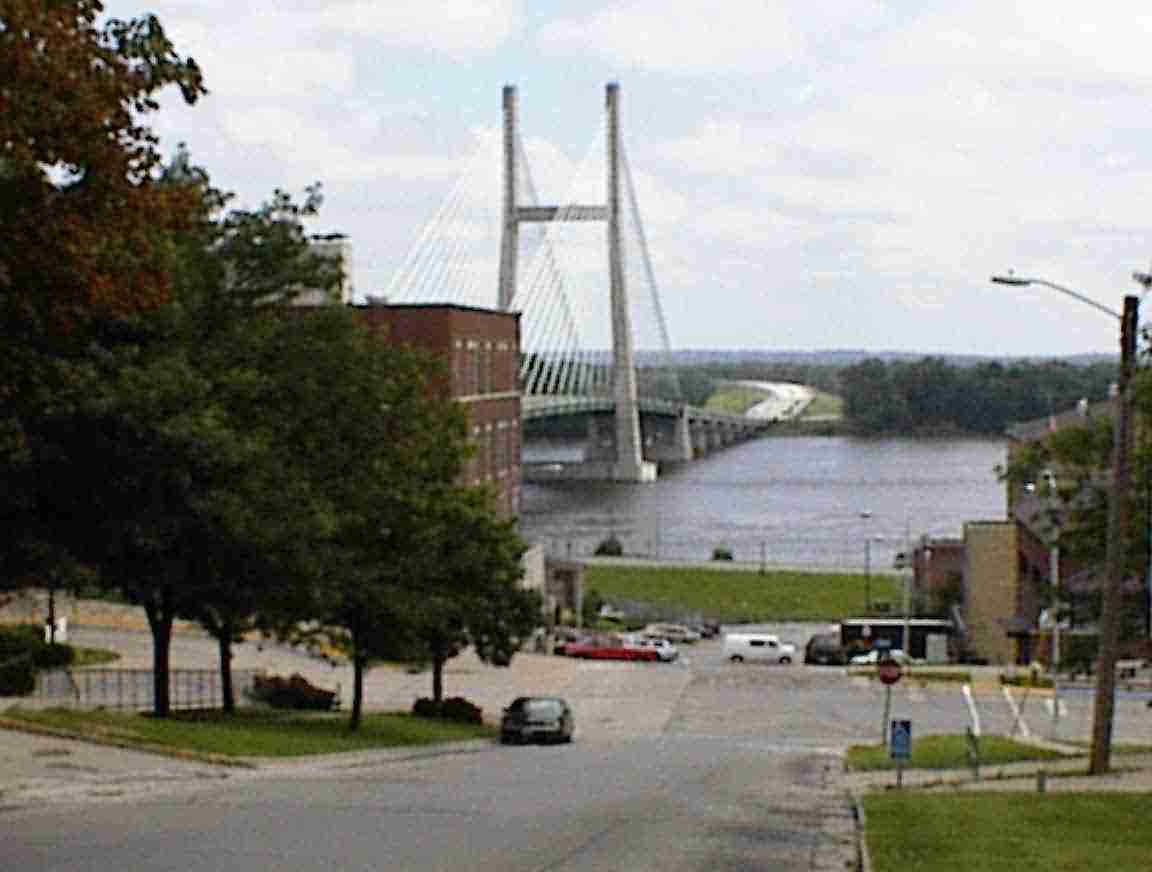
3 July - Day 35: Burlington IA to Galesbug IL - 84.2 km @ 18.1 km/h
When chronicling my trip through Iowa I forgot to include an observation on the Iowa drivers. A disconcertingly high number of them were reading as they drove along! I had pictures of myself ending up as a hood ornament on a pickup truck driven by a guy called Clem Kiddlehopper who wore a John Deere tractor baseball cap, was chewing on a wheat husk and was checking the prices of hog bellies in the paper as he drove along when he met this cyclist …
I had a good night’s sleep and did a bit of work in the morning before heading over to FedEx to (hopefully) collect my camera. It was not too far from the motel and I was pleased to find the replacement camera there. HP were very thorough with their returns system and the package included very detailed instructions and forms for returning the faulty camera. I made sure to test the new one and once I had formatted the memory card I was up and running with digital photos again! The delivery driver came in while I was doing all this and she commented that she had seen me on the road. I then entered into a delightful discussion with them about America and my travels. Like all Americans I have met they were proud of their country and pleased that I have been having such a good time and so many positive experiences.
From FedEx I went and got lunch at Wendy’s before heading down into the old town of Burlington. It was a very hilly city and as I was in the new part of town, built on the bluffs, it was a great downhill run into town. I passed many old warehouses and buildings which were a testimony to the position that the city once played as a gateway to the West. Many emigrants crossed the Mississippi here on their travels to a new life. In the distance I saw the famous river and the bridge to Illinois.

I came to the bottom of the road called ‘Snake Alley’ which was built in 1894. As the town expanded they found that they had problems insofar as the flat land by the Mississippi was used up so they had to go inland where it was quite hilly. They built an experimental switchback design between two of the neighbourhoods which was designed and constructed by some German immigrant engineers who had seen similar roads in the Ruhr. They constantly changed the camber from one curve to the next, keeping the high grade on the outside. The result was very impressive and the original brick pavement is still in use. The photos below show the road. There are 5 half-curves and two quarter-curves rising 58 feet over a distance of 275 feet.
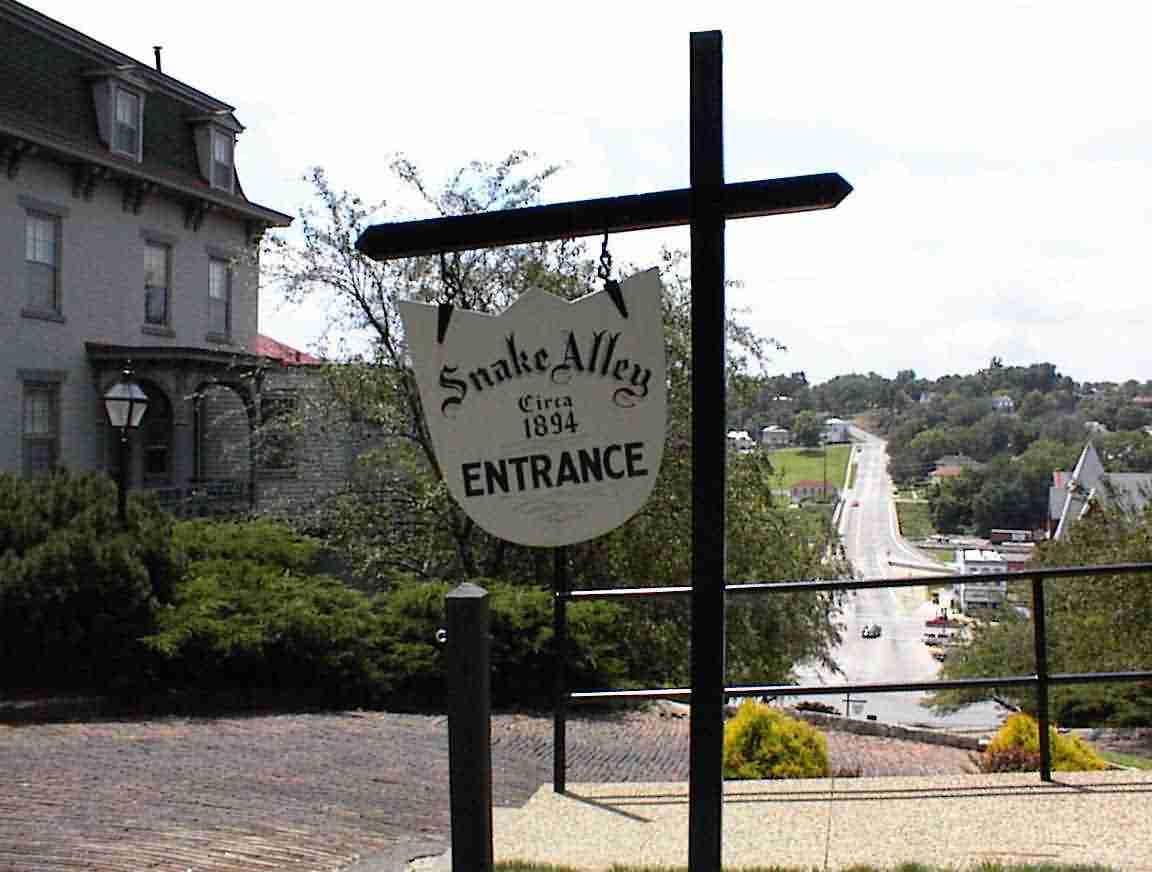
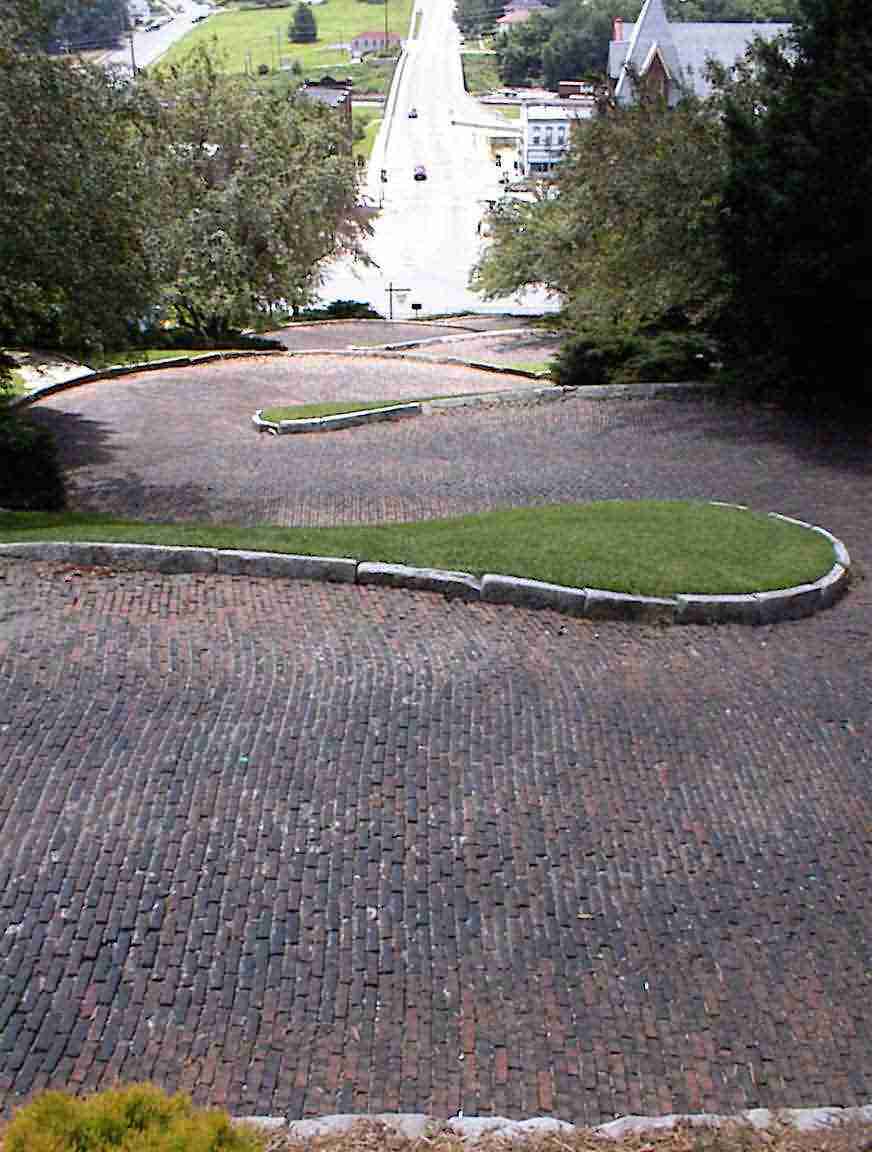
It was listed in Ripley’s ‘Believe it or Not’ as the "Crookedest Street in the World", something also claimed by San Francisco’s Lombard Street. I had wanted to see the latter in San Francisco due to that memorable chase scene with Steve McQueen in the film ‘Bullet’, but didn’t get around to it. Next visit.
Although successful from an engineering perspective, it was very difficult for horse carriages to navigate. By 1909 it was popular with auto traffic. A local history notes "In the early days, car dealers used Snake Alley for their test drives, with prospective buyers clinging to their seats while drivers accelerated up the curves. Today, many students in their driver’s education courses are put through the unique test". I drove down it and found it to be an interesting experience. The combination of the brick pavement and the tight curves required great concentration but it was also quite neat. If it had not been such a long way up I would have done it a second time.
From there I cycled down to the river. There was a visitor’s information centre near the bridge along with a public auditorium and I parked between them. Nancy, who worked at the auditorium, was out having a smoke and she kindly took the photo below. Another milestone met!
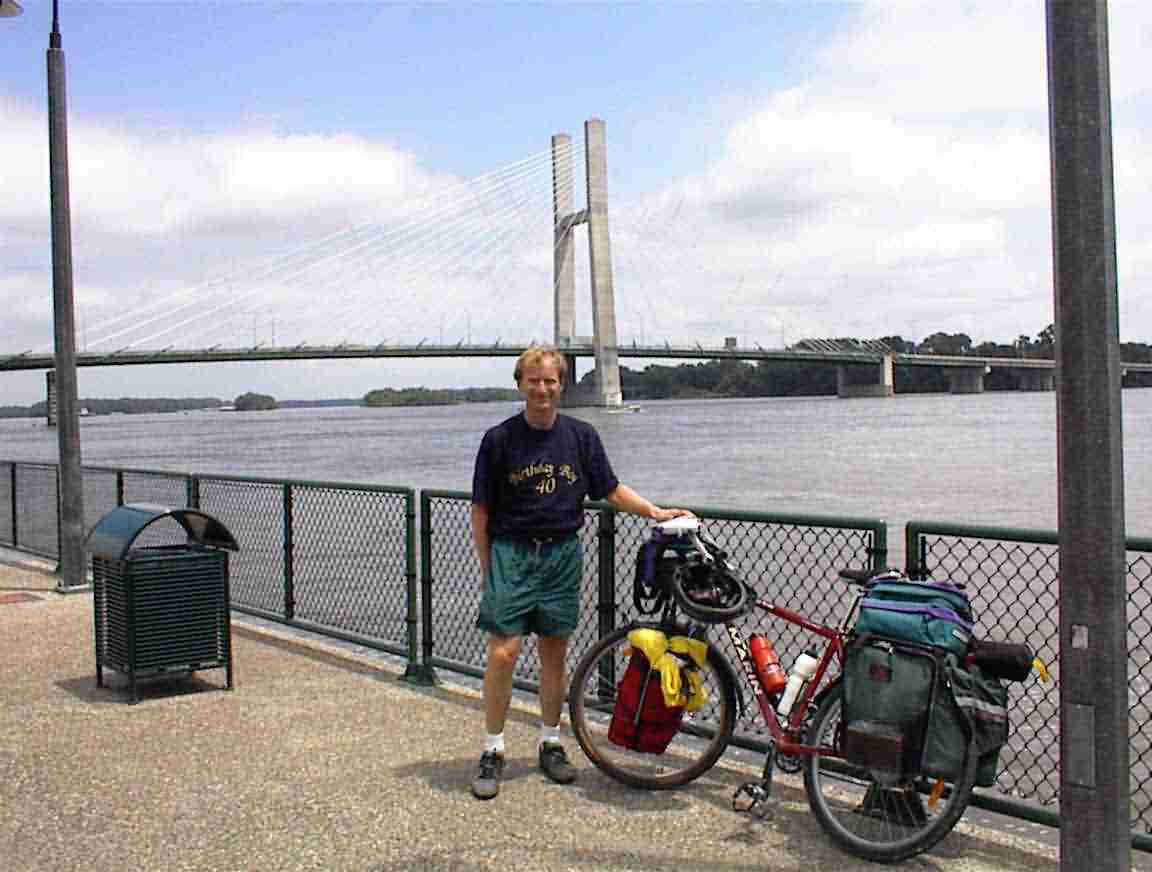
This is a good time to comment on smoking in the U.S.A. I once saw this film called ‘Field of Dreams’ about an elderly fellow who drove his tractor from Iowa to Wisconsin to visit his sick brother. One thing which struck me was the number of people in the film who smoked and I wondered if that was indicative of what it is like in this part of the U.S.A. It is. I would venture that about 5 to 10% of the traffic I pass have drivers smoking which is a huge number. Non-smoker’s rooms at motels are often hard to get—which shows that a large number are allocated for smokers—and it seems every time I am in a shop buying food there are people buying large numbers of cigarettes. I think that part of it is the pricing policy, based on the advertisements I suspect that cigarettes are about 1/3 the price of N.Z. Some Americans were lamenting to me that about 30% of the deaths in the U.S.A. are attributed to cigarettes; it is not surprising. End of diatribe …
There was a second part of ‘Field of Dreams’ which I was constantly reminded of: the RAGBRI. In the film this fellow is happily pottering along at 5 mph in his John Deere lawnmower when he is passed by a continuous stream of cyclists. This is the Recorder Annual Bike Ride Iowa (the Recorder being a newspaper)—or something like that. Nobody could tell me definitively what the acronym stood for but that was the one which was mentioned the most often. Each year they start with dipping their wheels in the Missouri river in the west and then spend a week cycling to the Mississippi river. A different route is taken each year and it draws 10-20,000 cyclists. This year it was ending in Burlington and a regular comment was that it was a pity I wasn’t there in a few more weeks to participate. No thanks. I prefer to have a quiet cycle.
I went into the visitor’s centre and found it most interesting. They had displays from several major companies in Iowa advertising their products—everything from Champion Spark Plugs to potato chips to artillery shells (seriously: there was a sample 105 mm projectile). I was surprised at the number of industries still in Burlington, but I guess that is because they are located in the new part of town instead of in the old port area. That is not surprising since the land is more readily available and suited to the needs of modern industry away from the centre of the old town.
There was a small display on steamboats and the impact that they had on the economy and settlement when they were introduced in the early 1800s. They opened up whole parts of the mid-West to commerce since they allowed for barges to be towed as well as travelling upstream on rivers that previously were only marginally navigable. A few years ago I read of the excavation of a sunk riverboat and the array of wares that they found. What surprised them was the level of comforts that immigrants and settlers both brought with them and had sent in; I guess that was one advantage to settling along the river insofar as the steamboat could bring in a few luxuries. When they had to rattle around the back of wagons. However, even then they still had luxuries, in Utah and Nevada I saw pianos and organs that were trundled out there on the pioneer trails. Today they run a steamboat between Burlington and Fort Madison as a casino; it spends six months of the year in each city.
There was a photo display of the history of the town showing such milestones as the first paving of the main street (concrete) and a lot of the old mansions that were blown out when they put through the highway. The latter was disconcerting since they were these glorious Victorian mansions with lots of character but they had the misfortune to be in the way of the new highway so were destroyed. Had it been N.Z. they would have been put on a truck and shipped somewhere.
This part of town is called ‘Heritage Hill’ and is on the National Register of Historic Places. It’s hillside setting with nineteenth century architecture and materials make it a very interesting place to wander around. There were brick sidewalks; cobblestones; outside cellar entrances; and an array of other features. Apparently, the high elevation of the hill was socially attractive during the latter part of the nineteenth century besides having obvious advantages with regard to flood protection, drainage, and being removed from the industry and commercial activities below. There were an amazing number of churches, both here and below, which spoke of a strong faith. Apparently there were three German language district churches all within a block of each other.
The centre was quite close to the river and I wondered about flooding. Sure enough they had some photos of the great flood of ’93 when the river flooded the lowest lying areas of the town, including the information centre. It was fascinating to see photos of the water half way up the walls, submerging many of the display cabinets but the funniest was the rescue boat parked in the lobby.
I headed back into town to explore some of the old town on the hill. As I was climbing up, it was quite steep, a couple drove up and chatted with me. They were very friendly and kindly asked to buy me lunch but I declined as I had recently eaten and it was getting late. After a short trip around town I headed for the bridge and over to Illinois. I stopped half-way across the bridge and took the photo below. The Mississippi really is huge and it is also very dirty. Indeed, some call it the big muddy and that is quite appropriate.
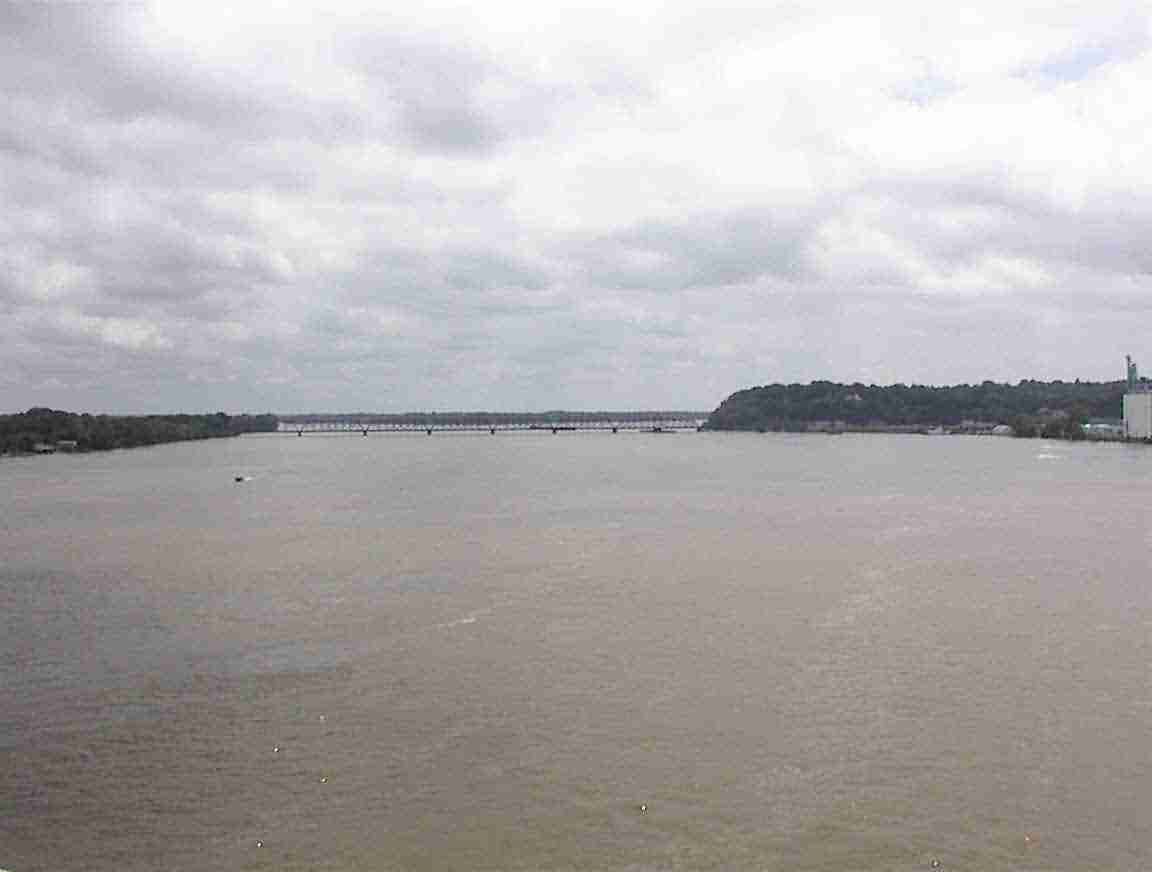
Once across the bridge I was in Illinois. This is the land of Abraham Lincoln, and you are not allowed to forget it. That is emblazoned on licence plates and they have the ‘Lincoln Trail’ which is a scenic route through the state.
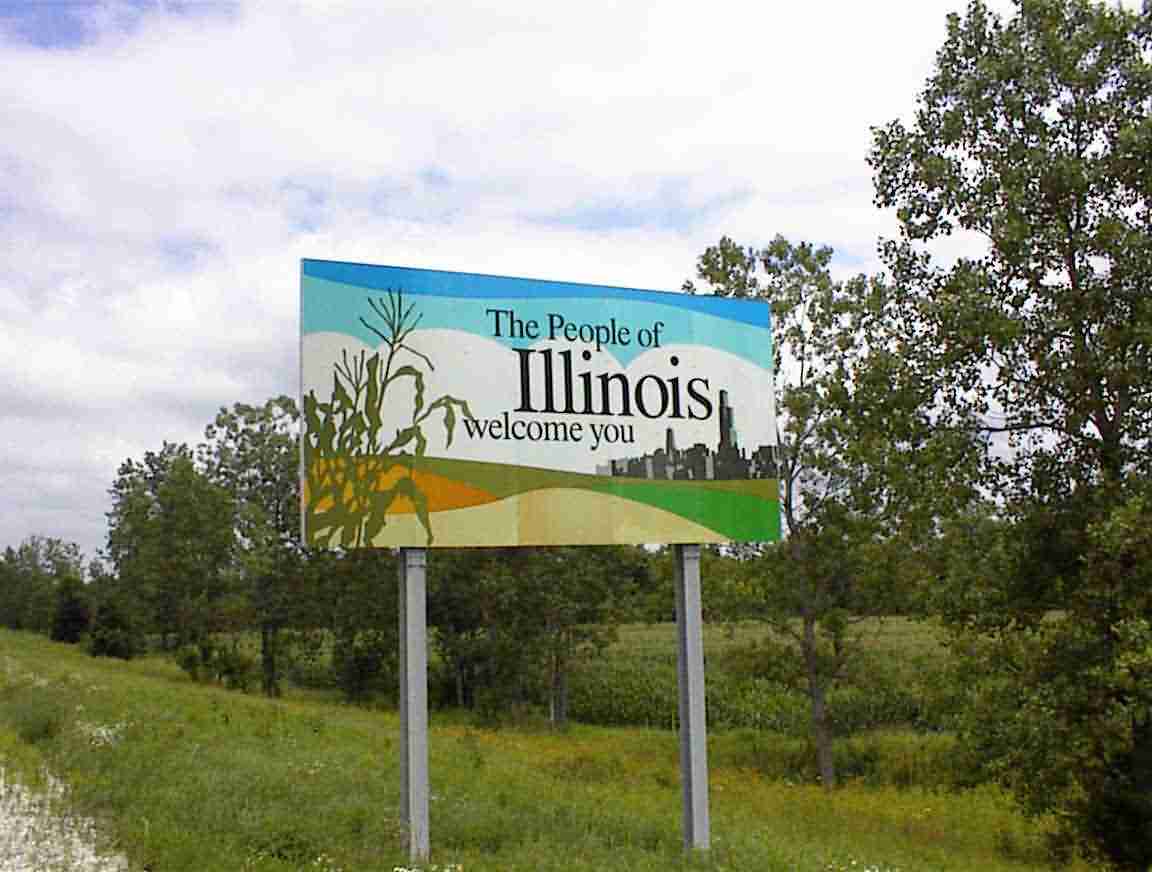 ri
ri
I was following Highway 34 and it really was quite busy. Although it started out as a divided highway and had a wide shoulder, it soon became two lanes with only a narrow strip to the right of the pavement. The traffic was relatively heavy so I wasn’t too pleased about this but I soldiered on. I must have overdone it a bit the day before since I really had no oomph in me. By the time I got to Monmouth I needed a break, even though I had only done 60 km.
Monmouth was a delightful town and very tidy and well kept. As I entered the town it had a sign saying it was the birthplace of Wyatt Earp. Now here was someone I had heard of! The famous Marshall from Tombstone Arizona who participated in the gunfight at the OK Corral. There were signs directing us to his birthplace, but I passed them by.
The next day was the 4th of July, when America celebrates its Declaration of Independence in 1776. I had seen flags everywhere and Monmouth was no exception. Some houses were particularly patriotic, such as the one in the photo below. One tradition is to put American flags on graves but in some cemeteries there were reports of the flags being looted. After an intensive investigation they found the culprits—squirrels. Apparently the flags make ideal nesting materials. No suspects as yet have been apprehended.
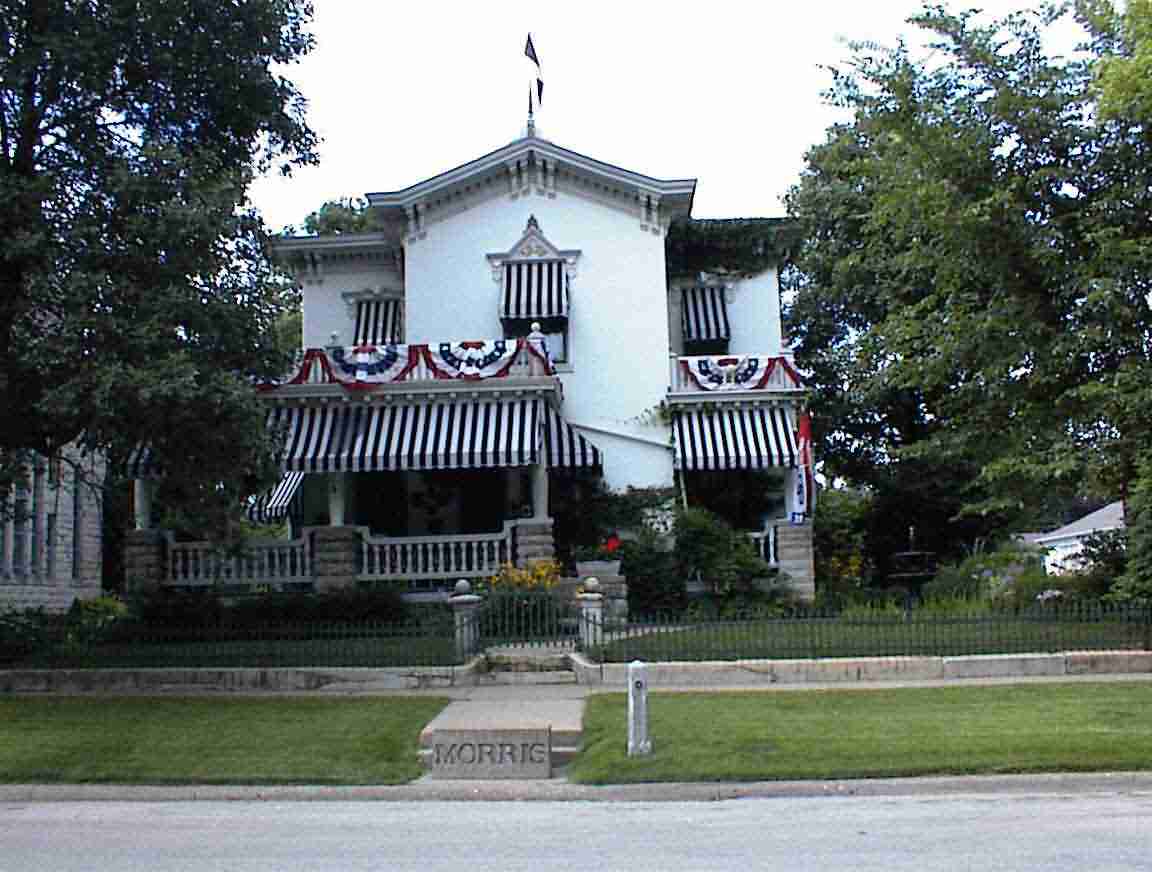 '
'
There was a lovely college in town with stately brick buildings with classical colonnades. It is such a pity that we now build them out of concrete since they just don’t have the same air of authority and tradition. As I cycled through town I found the college sports fields so stopped there for a rest. I don’t know why but they have made the bleachers so uncomfortable that I couldn’t sit in them for 10 minutes, let alone a whole baseball game. Perhaps the teams need the fans to stay awake? I read the paper and had some dried fruit and water. I was quite perky afterwards and continued on towards Galesburg.
Highway 34 became a divided highway between Monmouth and Galesburg and it was very busy, although it did fortunately have a nice wide shoulder. A short distance from town I found a quiet side road which also ran to Galesburg so I followed it instead. It was a good decision as the traffic was very light and it was a pleasure to cycle along, although slightly up and down—at least compared to the divided highway.
There were some farms with livestock and there was a tranquillity about the animals as they grazed in the late afternoon sun. The photo below is of a horse that was off on the side of the road.
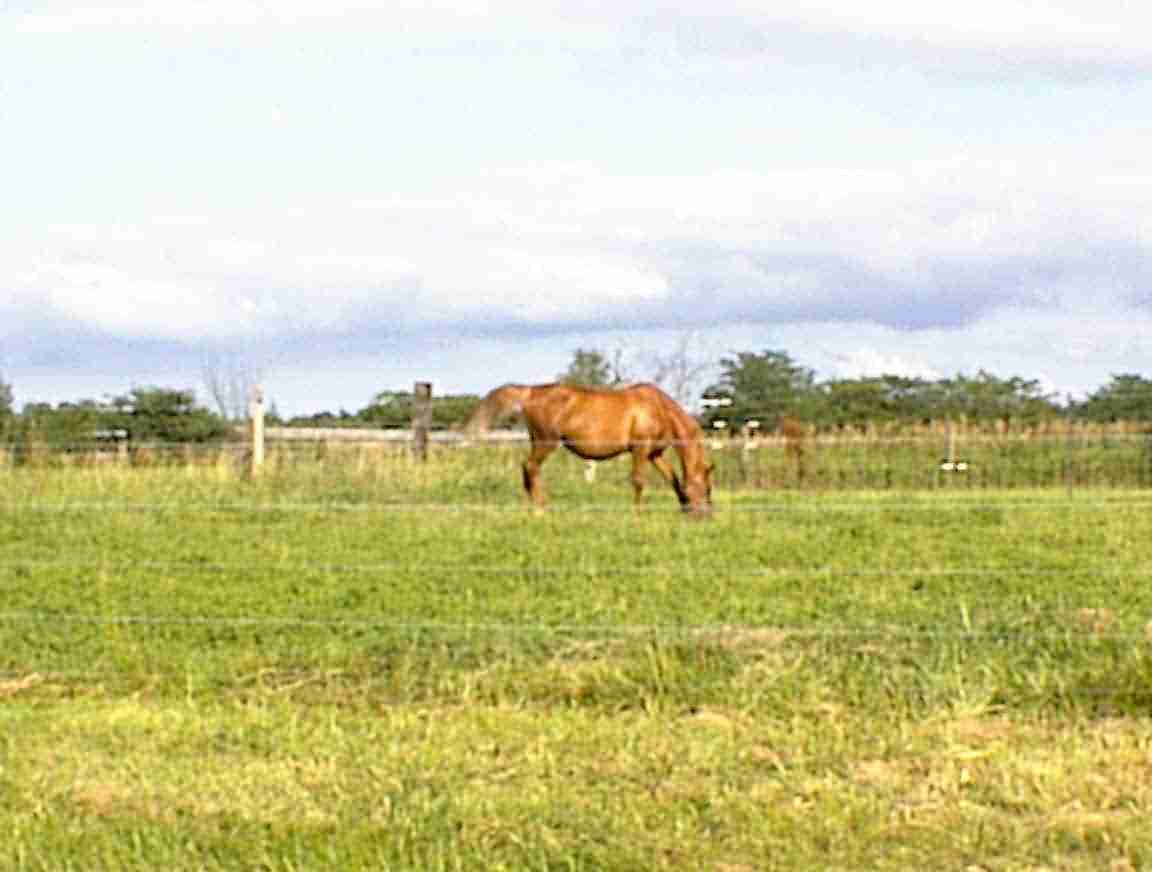
Otherwise, the scenery was much what I’ve seen elsewhere: corn an soybeans. The photo below is of a soybean field, but it really doesn’t capture just how vast these farms are; the crops go as far as the eye can see.
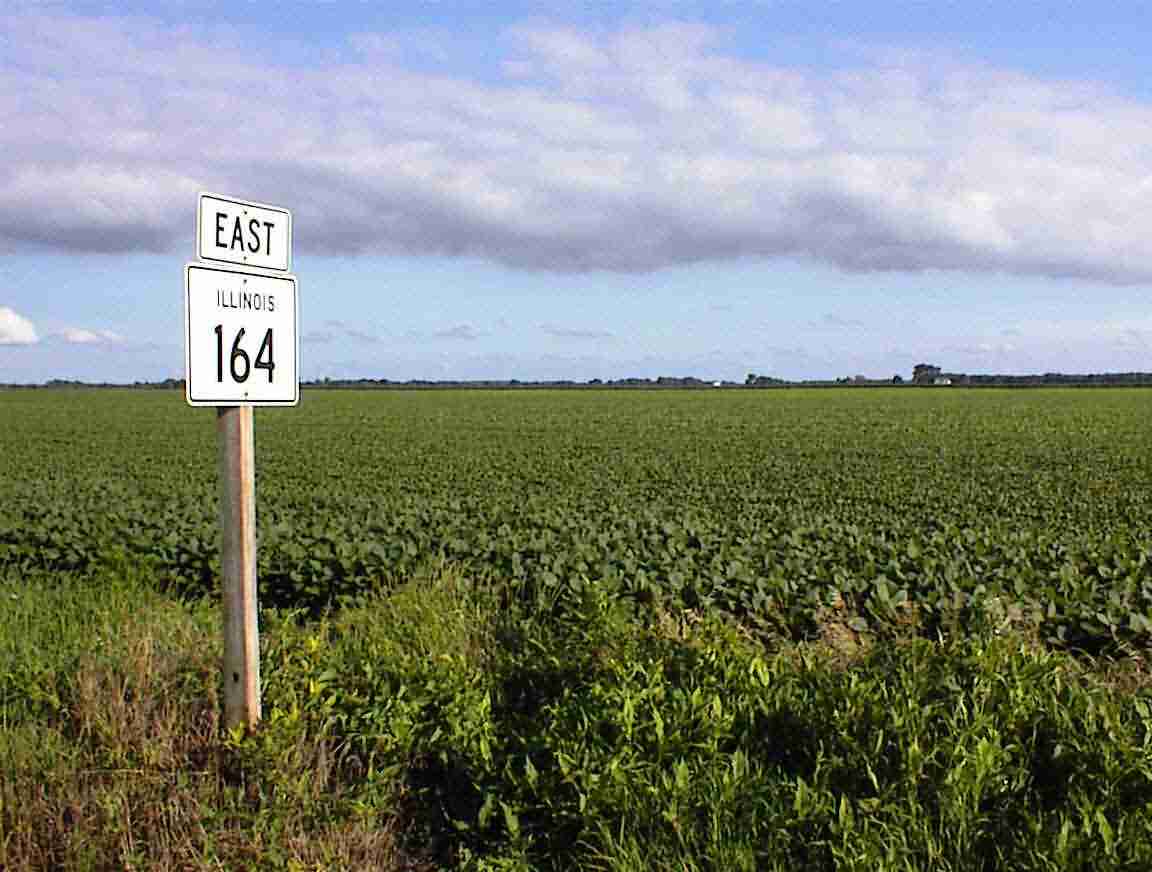
One major difference between Iowa and Illinois compared with Nebraska and Eastern Colorado was the absence of junked cars parked outside of the houses. Whereas farmers further west seemed to view parts of their properties as junk yards, this is not the same here. I didn’t see a single wreck in either state. There is also an air of more prosperity here, and that is perhaps why one doesn’t see things like these …
Eventually I reached Galesburg, home town of Carl Sandburg. They were quite proud of him as the signs announced that he was born here; there is the Carl Sandburg shopping centre; there is the Carl Sandburg homestead; and the Carl Sandburg park. If, like me, you have never heard of this man it only shows your ignorance; he is apparently a great poet.
I was still feeling under the weather a bit so I treated myself to a motel. After parking my bike I walked into town to see if I could get something to eat but everything was closed in anticipation of the holiday tomorrow. I got some pizza and a fruit juice at a petrol station and retired to my room and had an early night.
loans loans loans loans loans loans loans loans loans loans loans loans loans loans loans loans loans loans loans loans loans loans loans loans loans loans loans loans loans loans loans loans loansloans loans loans loans loans loans loans insurance insurance mortgage mortgage